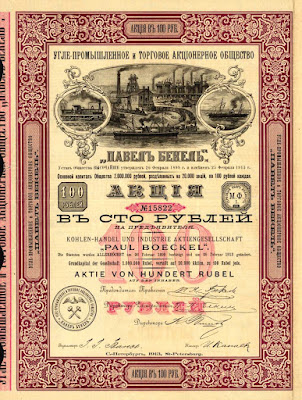During the weekend of April 6-7, the Crowne Plaza Hotel Antwerp becomes a mecca for scripophily. Many people have yet to discover this part of numismatics. Collecting antique and vintage stock certificates, aka scripophily, took off in the 1970s. People from all over the world are fascinated by the beauty and historic importance of these artefacts.
Antique stocks and bonds are, in comparison to coins, banknotes and stamps, much less available on the collector's market. Yet, keen collectors can still snap up amazing certificates at affordable prizes. The Boone auction house has been a specialist in scripophily for over four decades and is now holding its 62nd sale on the 6th of April in Antwerp.
More than 1600 lots will go on the block. Included are stocks and bonds from about 100 countries representing an equally large number of economic themes such as railways, technology, theatre, wine, casinos, gold mines, and much more.
The auction catalogue is available as a free PDF download. The work counts over 150 pages, provides a description for each lot and has extensive indexes on collecting topics. Hundreds of these antique securities have a splendid design made by renown artists like Hercule Louis Catenacci, Alphonse Mucha, Constant Montald, just to name a few. Others are signed by, or issued to celebrities like Jean-Baptiste Colbert, Alexander Hamilton and King Willem I.
Kohlen-Handel und Industrie Aktiengesellschaft "Paul Boeckel", 100 Rubel share, 1913, St. Petersburg
The company was formed in 1899 for the trade in coal, coke, pig-iron, cement, bricks and similar and to establish a coal-briquette factory. Detail of the vignette can be seen at the top.
L(ot) 1255 in the auction, start price €100
More than 1600 lots will go on the block. Included are stocks and bonds from about 100 countries representing an equally large number of economic themes such as railways, technology, theatre, wine, casinos, gold mines, and much more.
The auction catalogue is available as a free PDF download. The work counts over 150 pages, provides a description for each lot and has extensive indexes on collecting topics. Hundreds of these antique securities have a splendid design made by renown artists like Hercule Louis Catenacci, Alphonse Mucha, Constant Montald, just to name a few. Others are signed by, or issued to celebrities like Jean-Baptiste Colbert, Alexander Hamilton and King Willem I.
Société Columba Belge de Navigation - Service direct d'Anvers au Canada
This 500 Francs share was printed in 1894 by the Imprimerie du Journal La Bourse de Bruxelles.
In the second part of the 19th century Canada eagerly welcomed Belgian immigrants. Steamship companies offered interesting package deals to farm families. In 1898 a permanent Canadian office in Antwerp provided lectures and specific travel advice. Soon some 2000 Belgians a year entered their new country. The Columba Belge line operated a service from Antwerp to Canada, using four ships. L293 in the auction, this rare example of maritime scripophily starts at €400.
Boone's 62nd auction offers scripophily from all modern periods. Champagne Mumm, Siemens and Chrysler are some of today's famous names starring in the event. Moreover, the sale features certificates from the earliest modern period as well. These are rare, have a great historical importance and deserve a place in museums. Some examples :
- L205 Austrian Imperial Loan, signed by Kaiser Carl VI, 1732
- L773 Scottish bond from 1644 to finance war against England
- L1540 United States of America government bond signed by Alexander Hamilton 1791
One of the highlights is a certificate from the West-Indische-Compagnie (Dutch West India Company).
West-Indische-Compagnie, Middelburg, Transport share, 1792
In 1621 investors founded the Dutch West India Company (WIC). The enterprise obtained by charter the rights for a trade monopoly in the Dutch West Indies including jurisdiction over Atlantic possessions and participation in the Atlantic slave trade. The most spectacular success for the WIC was Piet Heyn's seizure of the Spanish silver fleet in 1628. Heyn captured more than 11 million guilders of booty in gold, silver and expensive trade goods. The company further became instrumental in the Dutch colonization of the Americas including New Amsterdam that covered parts of present-day New York, Connecticut, Delaware, and New Jersey. Historic and extremely rare, L892 in the auction is expected to realize €10,000.
The day after the sale, Mario Boone organizes his regular scripophily bourse internationally attended by dealers and visitors.
Auction details
- Location : Antwerpen, Belgium
- Date : auction 6 April 2019, bourse 7 April 2019
- Further info : online catalogue here, and PDF version there
F.L.
PS : You can find out more about the American railroads in the auction in this preview from Coxrail










